从零开始手把手教你写一个基于nRF54L15的BLE工程
最近收到了Nordic最新的旗舰级BLE芯片 nRF54L15的开发板,大概研究了一下,今天教大家怎么在上面把BLE跑起来。
前言:开发板概览
1、打开包装之后里面是用防静电袋包装的开发板和NFC天线,nRF54L15DK的代号是PCA10156,但是nRF54L15的开发板对比nRF52832的开发板来看,nRF54L15的开发板没有再采用Arduion接口将IO引出。开发板上用到的元器件也少了很多,看下来只用到五颗主芯片。
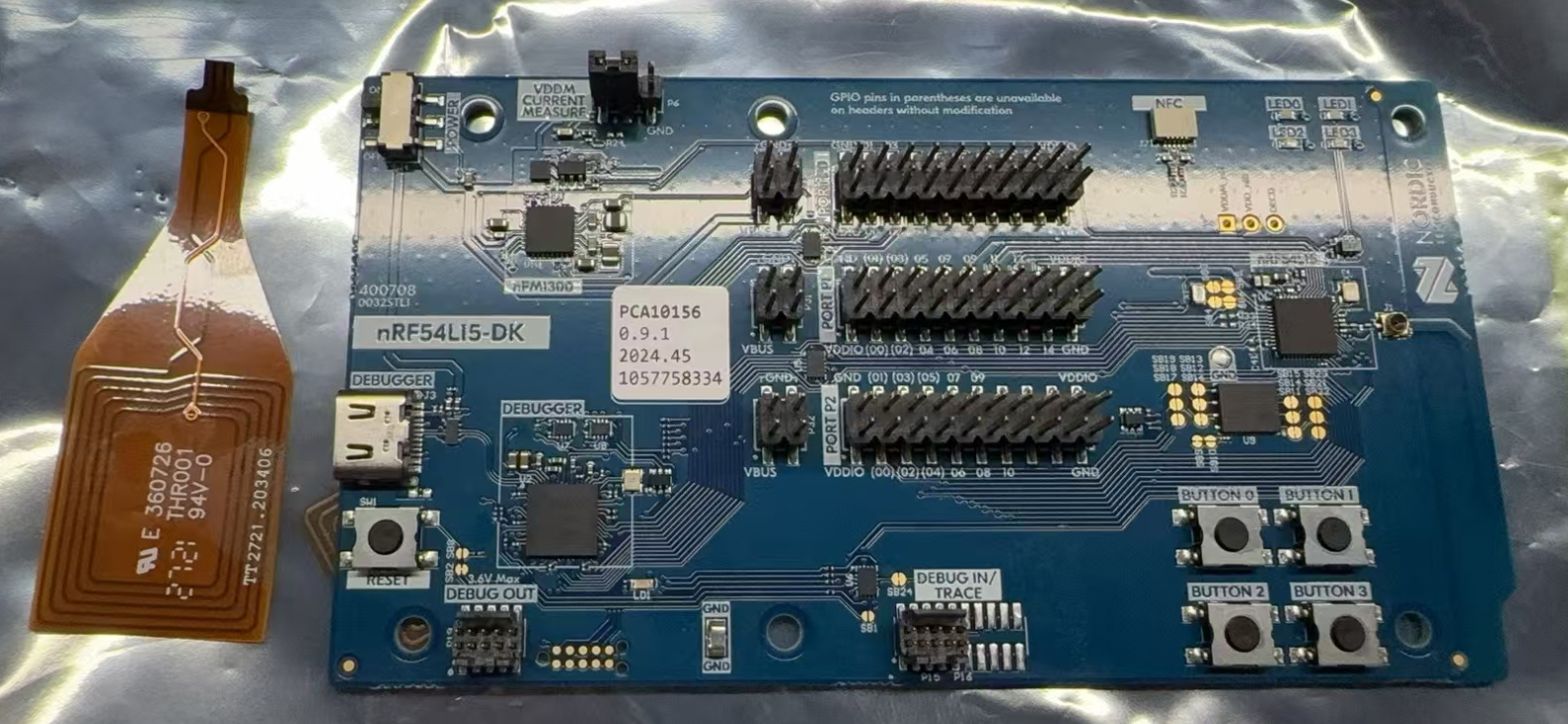
开发板的JLINK芯片用的是Nordic的nRF5340,JLINK的USB口换成了Typc-C口。
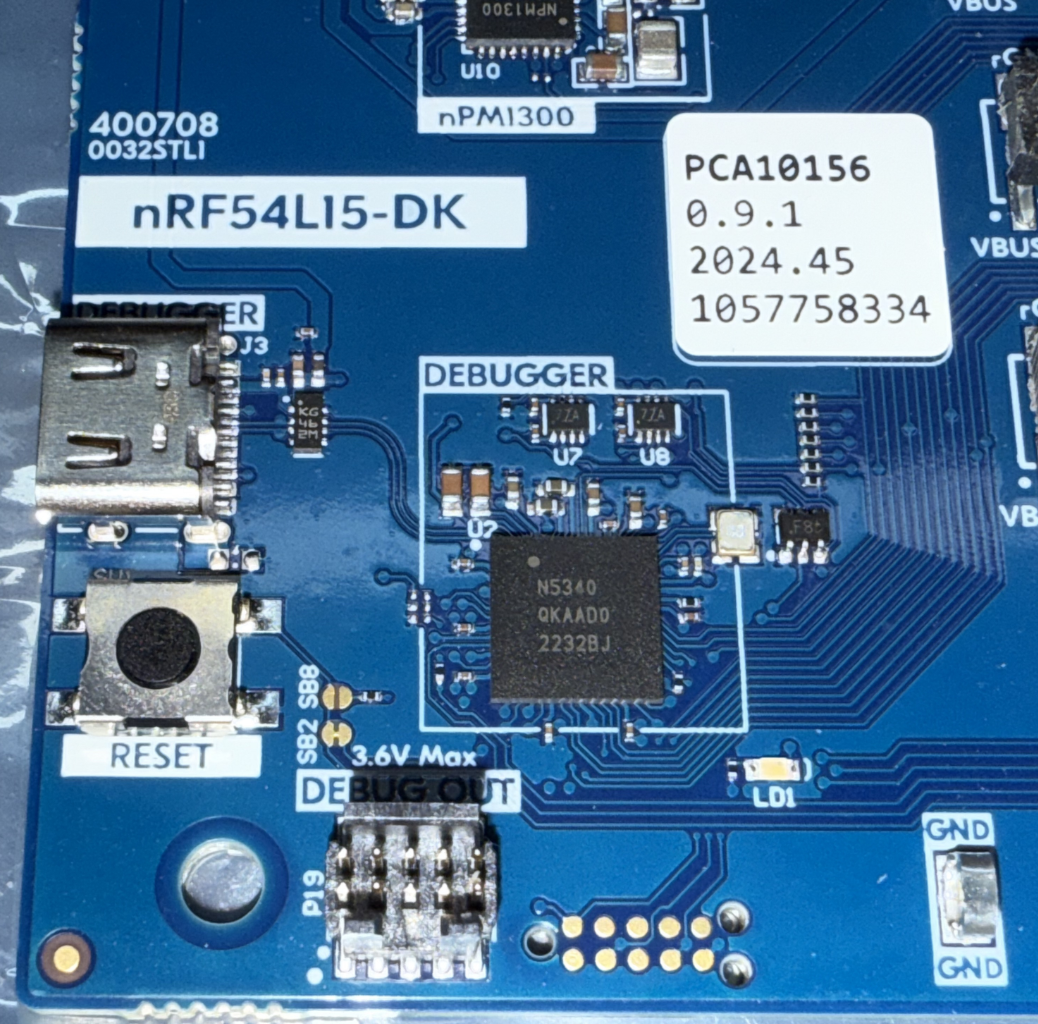
电源芯片用上了Nordic自己的PMIC nPM1300
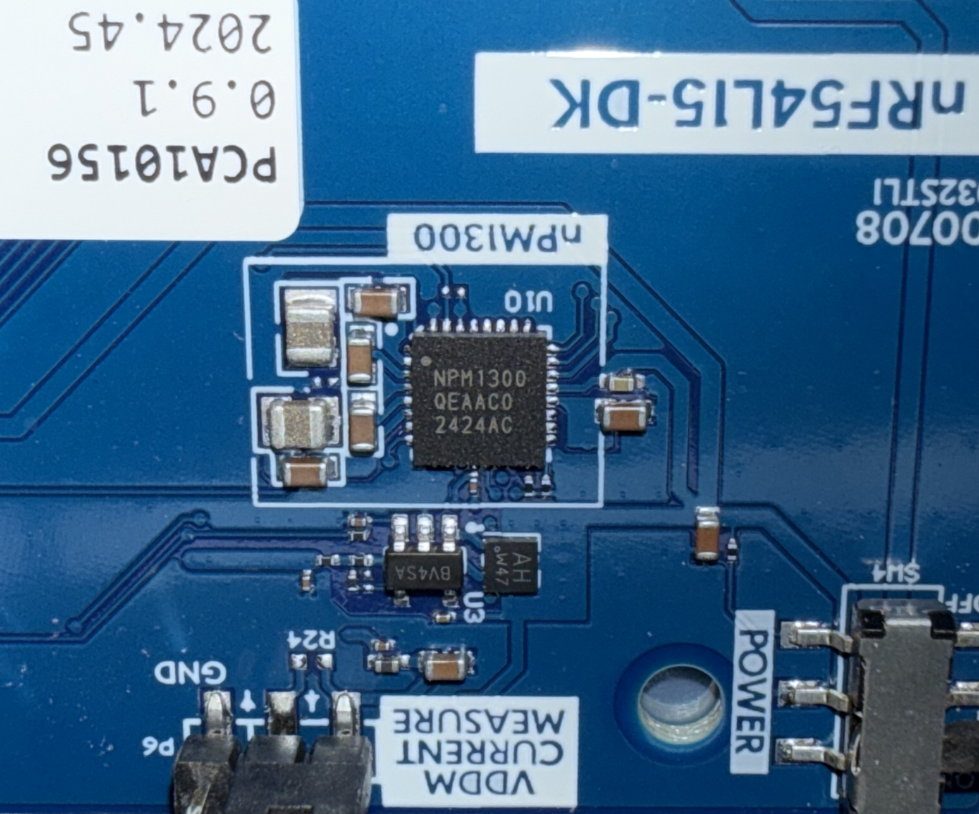
最后来看一下nRF54L15部分,这里外挂了一个MXIC 64Mbit的flash,nRF54L15最小系统的元器件也少了很多。
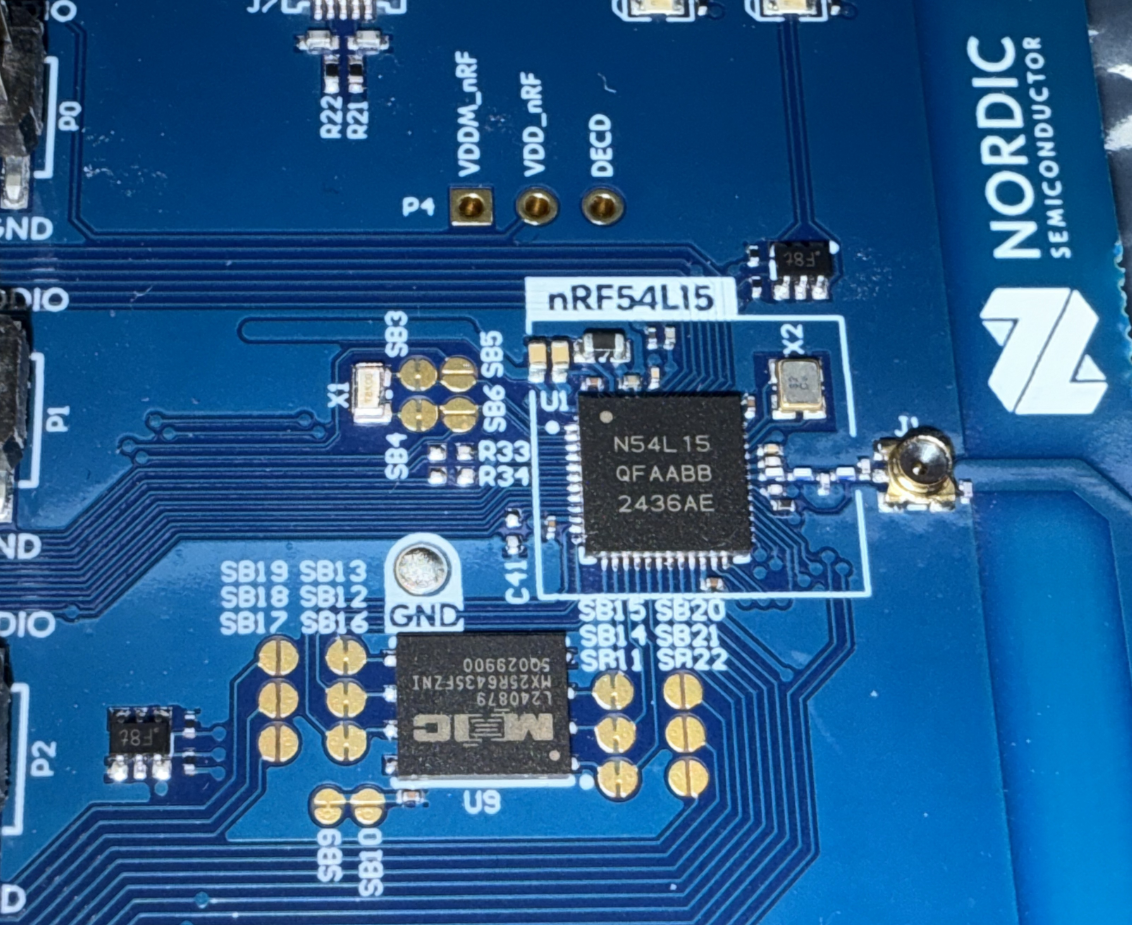
在网上可以找到nRF54L15的资料:
介绍:https://www.nordicsemi.com/Products/nRF54L15
规格书:https://docs-be.nordicsemi.com/bundle/ps_nrf54L15/attach/pdf/nRF54L15_nRF54L10_nRF54L05_Datasheet_v0.7.pdf
硬件设计:https://www.nordicsemi.com/-/media/Software-and-other-downloads/Reference-Layouts/nRF54L15/nRF54L15-QFAA-Reference-Layout-0_7.zip
2、环境搭建
根据我原厂的朋友的说法,新的nRF54L15需要用到NRF Connect SDK去开发,
这里环境搭建可以参考官方的文档:Installing the nRF Connect SDK (nordicsemi.com)
最新的文档已经推荐使用nrfutil来下载SDK了,但是我个人还是更喜欢用west的方式
这里可以参考中国区原厂FAE的博客:开发你的第一个nRF Connect SDK(NCS)/Zephyr应用程序 - iini - 博客园 (cnblogs.com)
按照博客中的方法安装好Choco和相关的工具之后,直接执行下面两条命令即可:
west init -m https://github.com/nrfconnect/sdk-nrf --mr v2.9.0
west update
nRF54系列的SDK要使用NCS 2.7.0及以上的版本,下载SDK的时候需要注意。
NRF CONNECT SDK现在的编译环境也换成了VS Code + Nordic插件的方式,这里的编译环境搭建也可以参考上面中国区原厂FAE的博客。
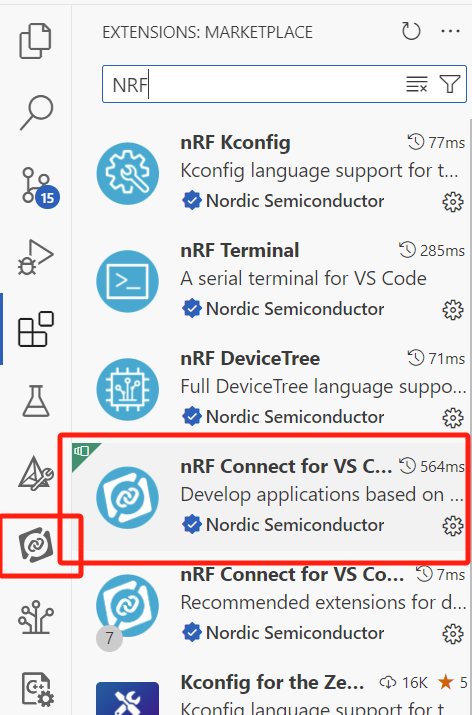

一、在nRF54L15D上运行你的第一个程序
1、搭建好环境之后,首先我们从SDK中Copy一个Hello World的工程
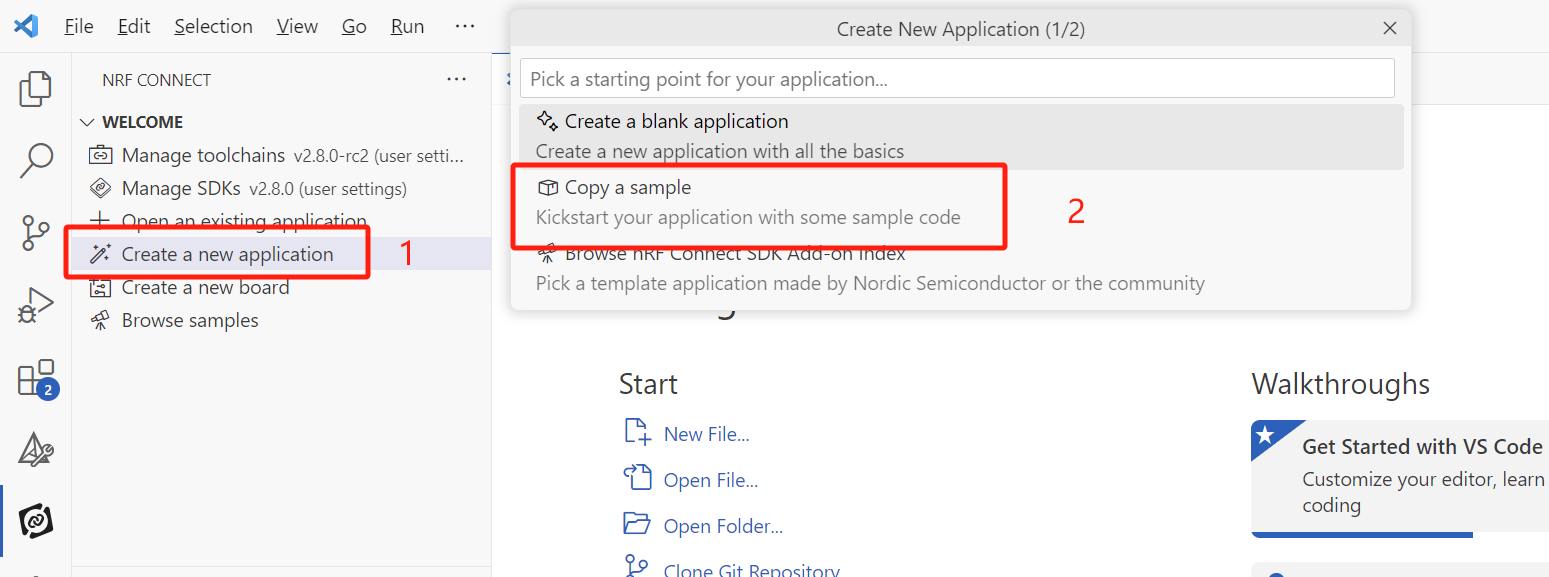
2、编译在NRF54L15DK上运行,这里需要注意NCS2.7.x及以上的版本在编译的时候需要选择SysBuild

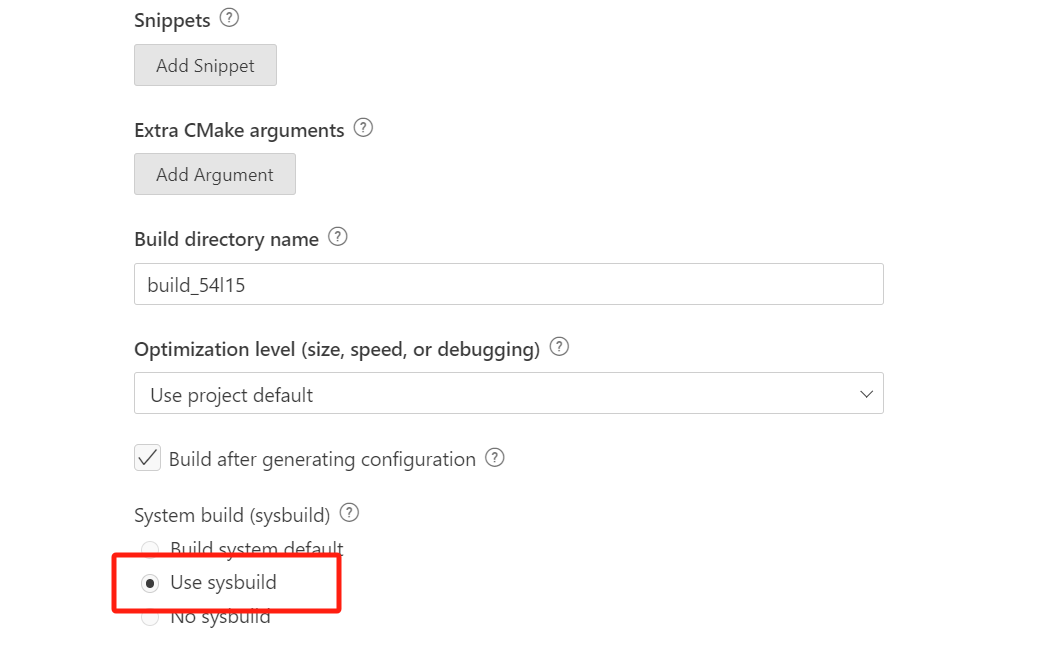
3、程序编译之后下载到nRF54L15DK中,打开串口我们可以看到串口打印如下:
分别是NCS和Zephyr的版本,以及Hello World!和Boards的型号
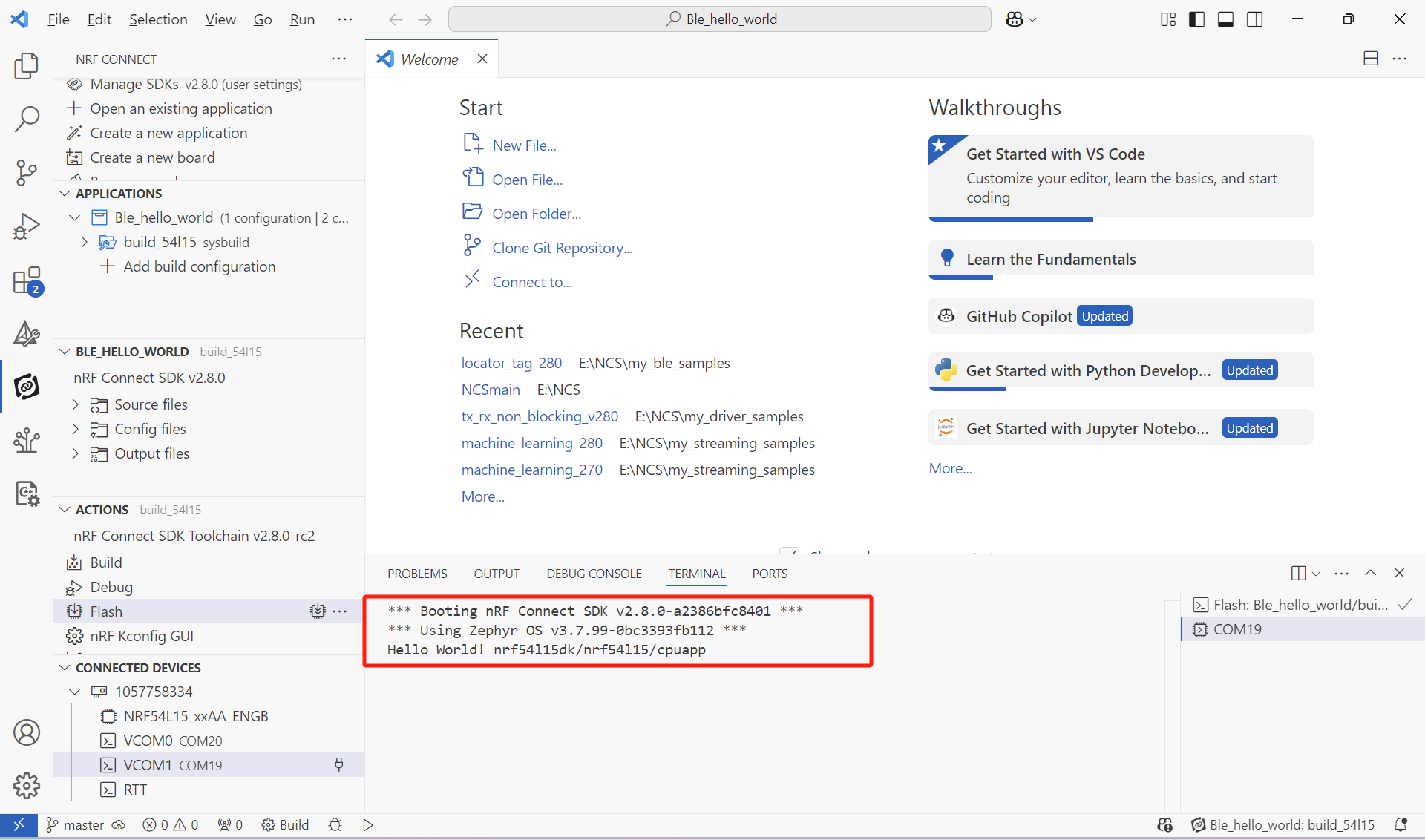
4、我们打开这个工程的main.c,可以看到这个工程非常简单,就是调用了printf来打印Hello World!和CONFIG_BOARD_TARGET这个宏
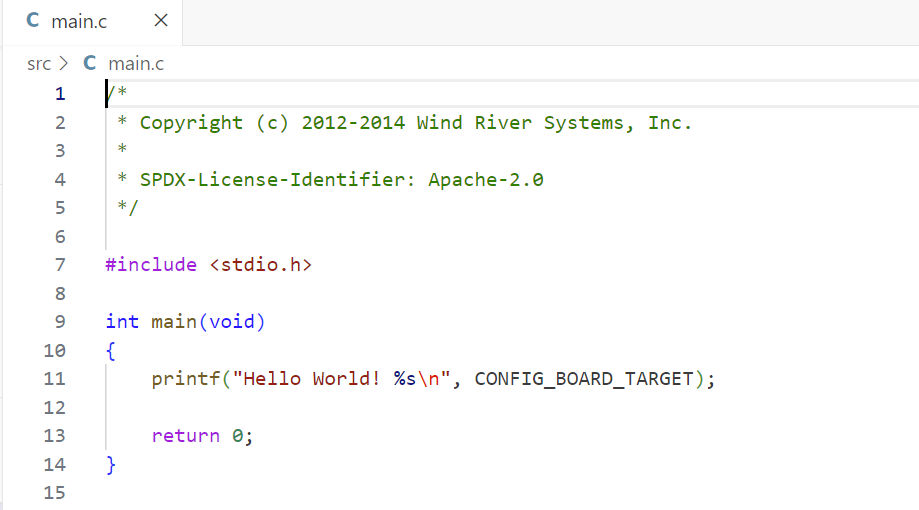
二、添加LOG模块
上面的Hello World使用了printf来打印,在我们的程序里面可以调用LOG模块来打印调试日志,这样方便我们后续在产品量产的时候关闭LOG模块
1、这里我们先在hello_world/prj.conf中下面这些的宏,开启LOG
#Config logger CONFIG_LOG=y CONFIG_USE_SEGGER_RTT=n CONFIG_LOG_BACKEND_RTT=n CONFIG_LOG_BACKEND_UART=y CONFIG_LOG_DEFAULT_LEVEL=3
2、在main.c中加入下面这些头文件,调用LOG的库,并注册LOG模组
//Add Log Library file #include <zephyr.h> #include <zephyr/logging/log.h>
//Register LOG Module
#define LOG_MODULE_NAME ble_hello_world LOG_MODULE_REGISTER(LOG_MODULE_NAME);
3、这里我们提前写一个bluetooth_init的函数,并在bluetooth_init中加入一些LOG信息
int bluetooth_init(void) { int err_code; LOG_INF("Initiallzing BLE"); err_code = 0; return err_code; }
4、、在main函数中调用函数 bluetooth_init
int main(void) { int err_code; err_code = bluetooth_init(); if(err_code){ LOG_ERR("Bluetooth_init returnrd %d", err_code) } printf("Hello World! %s\n", CONFIG_BOARD_TARGET); }
5、我们来编译并下载程序到nRF54L15DK中会看到程序进入了bluetooth_init 并在串口打印了LOG:

三、使能协议栈
1、接下来,我们需要加入BLE相关的头文件
//Add BLE Library file #include <zephyr/bluetooth/bluetooth.h> #include <zephyr/bluetooth/uuid.h> #include <zephyr/bluetooth/gatt.h> #include <zephyr/bluetooth/hci.h>
2、prj.conf中加入这些宏,开启BLE相关的宏
3、在 bluetooth_init中调用bt_enable,这是一个库函数,这个函数的定义的bluetooth.h中,因为bt_enable只负责调度BLE协议栈的启动,而在执行其他函数之前需要确保协议栈完成了启动,所以我们要做一个简单判断
int bluetooth_init(void) { int err_code; err_code = bt_enable(bt_ready_callback); if(err_code) { LOG_ERR("BLE Enable returned %d",err_code);
return err_code;
} LOG_INF("Initiallzing BLE"); return err_code; }
3、我们去看一下这个函数的用法,这里看到bt_enable需要一个回调函数
/** * @brief Enable Bluetooth * * Enable Bluetooth. Must be the called before any calls that * require communication with the local Bluetooth hardware. * * When @kconfig{CONFIG_BT_SETTINGS} is enabled, the application must load the * Bluetooth settings after this API call successfully completes before * Bluetooth APIs can be used. Loading the settings before calling this function * is insufficient. Bluetooth settings can be loaded with settings_load() or * settings_load_subtree() with argument "bt". The latter selectively loads only * Bluetooth settings and is recommended if settings_load() has been called * earlier. * * @param cb Callback to notify completion or NULL to perform the * enabling synchronously. The callback is called from the system workqueue. * * @return Zero on success or (negative) error code otherwise. */ int bt_enable(bt_ready_cb_t cb);
我们再去看bt_ready_cb_t这个参数的定义,从这个注释中可以得知这个回调的作用是通知BLE已使能
/** * @typedef bt_ready_cb_t * @brief Callback for notifying that Bluetooth has been enabled. * * @param err zero on success or (negative) error code otherwise. */ typedef void (*bt_ready_cb_t)(int err);
所以为了确保BLE协议栈已经完成了使能,我们需要自己写一个回调函数
/*BLE Enable Callback function*/ void bt_ready_callback(int err_code) { if(err_code) { LOG_ERR("BLE Enable callback returned %d",err_code); } }
4、这里我们在bluetooth_init中添加一个信号量,等待bt_ready_cb_t通知协议栈已使能,这里我们调用K_SEM_DEFINE初始化一个信号量,并将其计数设为 1、界限设为 1,然后在bluetooth_init中调用k_sem_take()获取这个信号量,因为我们将计数设置为了1,所以程序会一直在bt_enable()这里等待协议栈使能完成,当然可以将K_FOREVER设置为一个时间,超时之后程序会继续往下执行。
static K_SEM_DEFINE(ble_init_ok, 1, 1);
int bluetooth_init(void) { int err_code;
LOG_INF("Initiallzing BLE");
err_code = bt_enable(bt_ready_callback); if(err_code) { LOG_ERR("BLE Enable returned %d",err_code); return err_code; } k_sem_take(&ble_init_ok, K_FOREVER); return err_code; }
因为这里我们要确保BLE协议栈使能完成,所以我们可以在bt_ready_callback()中释放这个信号量,这样我们可以通过信号量的同步得知BLE协议栈已经被使能。
/*BLE Enable Callback function*/ void bt_ready_callback(int err_code) { if(err_code) { LOG_ERR("BLE Enable callback returned %d",err_code); }
k_sem_give(&ble_init_ok); }
5、最后我们编译看一下有什么效果,这里可以看到BLE协议栈已经被使能,并打印了版本信息等LOG
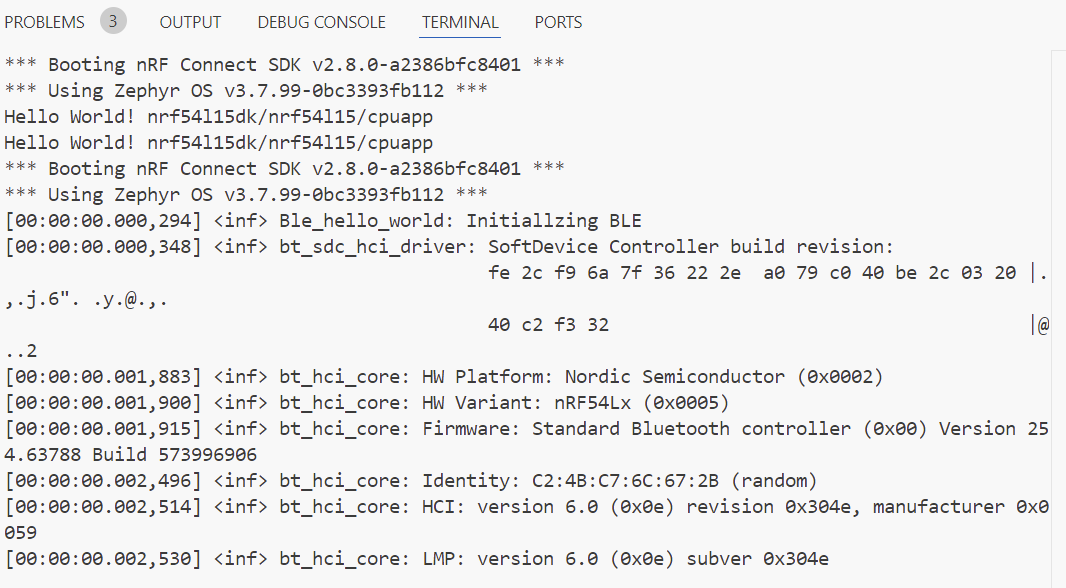
四、开启广播
使能BLE协议栈之后,我们接下来要做的就是开启一个BLE广播
1、我们来设置广播包的内容,我们可以在广播包中加入UUID,这里我们可以写一个宏来定义UUID的号码
/** @brief UUID of the Hello World Service. **/ #define BT_UUID_HOWD_VAL \ BT_UUID_128_ENCODE(0x6e400001, 0xb5a3, 0xf393, 0xe0a9, 0xe50e24dcca9e) #define BT_UUID_HOWD_SERVICE BT_UUID_DECLARE_128(BT_UUID_HOWD_VAL)
2、我们写一个宏来设置广播名称,这个宏最终调用的是在prj.conf中CONFIG_BT_DEVICE_NAME的值,这里我的定义是CONFIG_BT_DEVICE_NAME="BLE_Hello_World"
/*Config BLE Device Name*/ #define DEVICE_NAME CONFIG_BT_DEVICE_NAME #define DEVICE_NAME_LEN (sizeof(DEVICE_NAME) - 1)
3、最后我们把上面的UUID和名称放在广播包数据中,这里我把UUID放在了Scan response里面
/*Config BLE Advertising Data*/ static const struct bt_data ad[] = { BT_DATA_BYTES(BT_DATA_FLAGS, (BT_LE_AD_GENERAL | BT_LE_AD_NO_BREDR)), BT_DATA(BT_DATA_NAME_COMPLETE, DEVICE_NAME, DEVICE_NAME_LEN), }; /*Config BLE Scan repsponse Data*/ static const struct bt_data srd[] = { BT_DATA_BYTES(BT_DATA_UUID128_ALL, BT_UUID_HOWD_VAL), };
4、完成广播数据定义之后,我们就可以在bluetooth_init()中调用bt_le_adv_start()来开启广播了。
int bluetooth_init(void) { int err_code; LOG_INF("Initiallzing BLE"); bt_conn_cb_register(); err_code = bt_enable(bt_ready_callback); if(err_code) { LOG_ERR("BLE Enable returned %d",err_code); return err_code; } k_sem_take(&ble_init_ok, K_FOREVER); err_code = bt_le_adv_start(BT_LE_ADV_CONN, ad, ARRAY_SIZE(ad), srd, ARRAY_SIZE(srd)); if (err_code) { LOG_ERR("Advertising failed to start (err_code %d)", err_code); return 0; } return err_code; }
这里我们可以去看一下bt_le_adv_start()这个函数的用法,这是一个库函数,可以在bluetooth.h中找到声明,可以看到这个函数一共有5个入参,分别是
1)const struct bt_le_adv_param *param,是包括广播周期、广播类型等参数
2)const struct bt_data *ad, size_t ad_len,分别是广播包数据和广播包的长度
3)const struct bt_data *sd, size_t sd_len,分别是扫描响应包数据和扫描响应包的长度
/** * @brief Start advertising * * Set advertisement data, scan response data, advertisement parameters * and start advertising. * * When the advertisement parameter peer address has been set the advertising * will be directed to the peer. In this case advertisement data and scan * response data parameters are ignored. If the mode is high duty cycle * the timeout will be @ref BT_GAP_ADV_HIGH_DUTY_CYCLE_MAX_TIMEOUT. * * This function cannot be used with @ref BT_LE_ADV_OPT_EXT_ADV in the @p param.options. * For extended advertising, the bt_le_ext_adv_* functions must be used. * * @param param Advertising parameters. * @param ad Data to be used in advertisement packets. * @param ad_len Number of elements in ad * @param sd Data to be used in scan response packets. * @param sd_len Number of elements in sd * * @return Zero on success or (negative) error code otherwise. * @return -ENOMEM No free connection objects available for connectable * advertiser. * @return -ECONNREFUSED When connectable advertising is requested and there * is already maximum number of connections established * in the controller. * This error code is only guaranteed when using Zephyr * controller, for other controllers code returned in * this case may be -EIO. */ int bt_le_adv_start(const struct bt_le_adv_param *param, const struct bt_data *ad, size_t ad_len, const struct bt_data *sd, size_t sd_len);
在上面的代码中,广播参数也调用了一个现成的宏,这个宏在bluetooth.h中可以找到,在这个宏里面可以看到参数主义是定义了广播类型为可连接广播,快速广播的最小周期和最大周期。此外广播包中还定义了一下flag等,感兴趣的读者可以自行去看下面这几个宏
BT_DATA_BYTES(BT_DATA_FLAGS, (BT_LE_AD_GENERAL | BT_LE_AD_NO_BREDR)
#define BT_LE_ADV_CONN BT_LE_ADV_PARAM(BT_LE_ADV_OPT_CONNECTABLE, \ BT_GAP_ADV_FAST_INT_MIN_2, \ BT_GAP_ADV_FAST_INT_MAX_2, NULL)
/** * @brief Advertise as connectable. * * Advertise as connectable. If not connectable then the type of * advertising is determined by providing scan response data. * The advertiser address is determined by the type of advertising * and/or enabling privacy @kconfig{CONFIG_BT_PRIVACY}. */ BT_LE_ADV_OPT_CONNECTABLE = BIT(0),
此外bluetooth.h中除了BT_LE_ADV_CONN BT_LE_ADV_PARAM之外,还有其他好多个广播参数,感兴趣的读者可以去看看其他的宏分别定义了一些什么。
5、最后我们编译工程来看一下有什么效果,我们可以使用nRF Connect app去查看一下广播数据
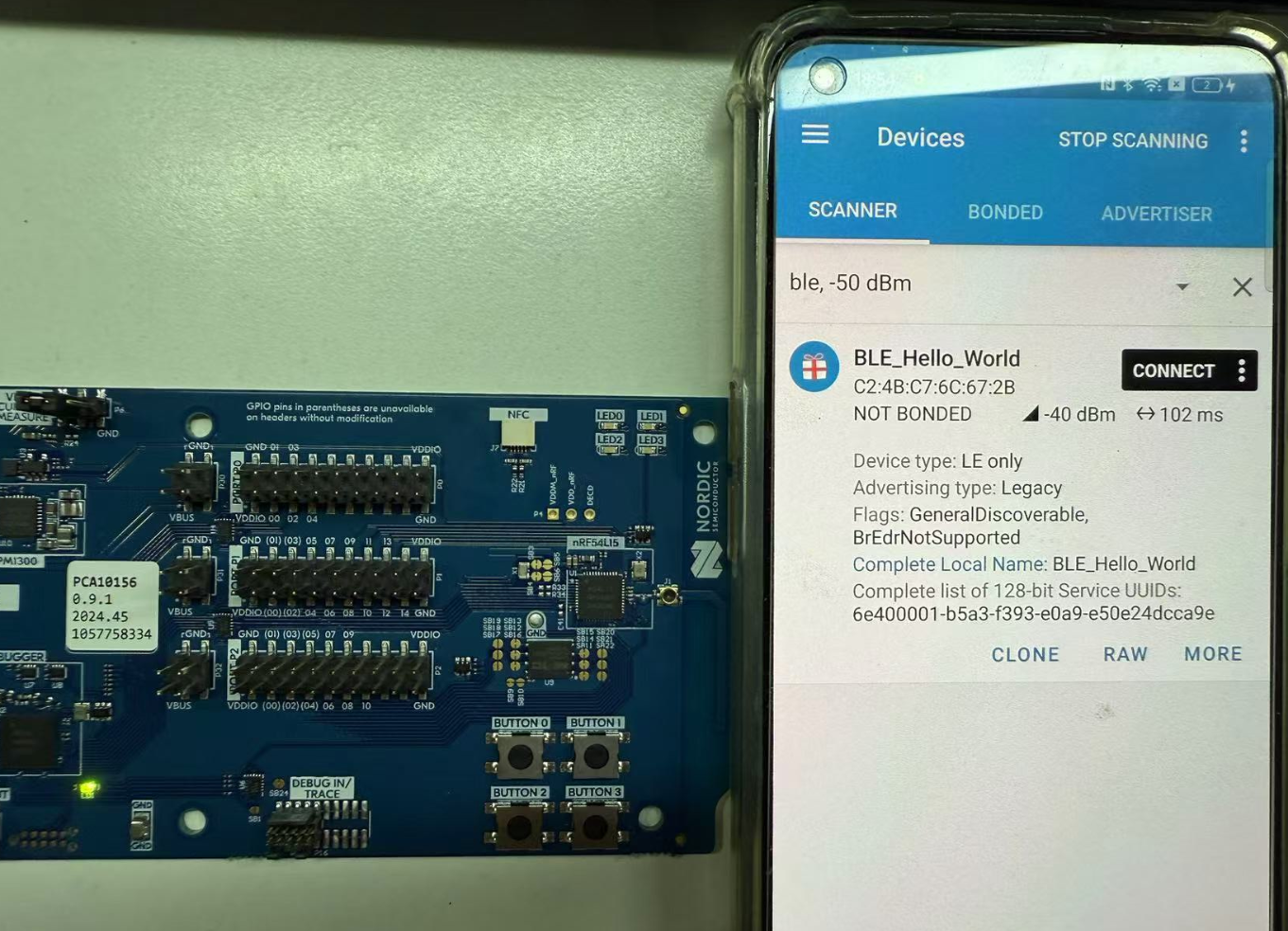
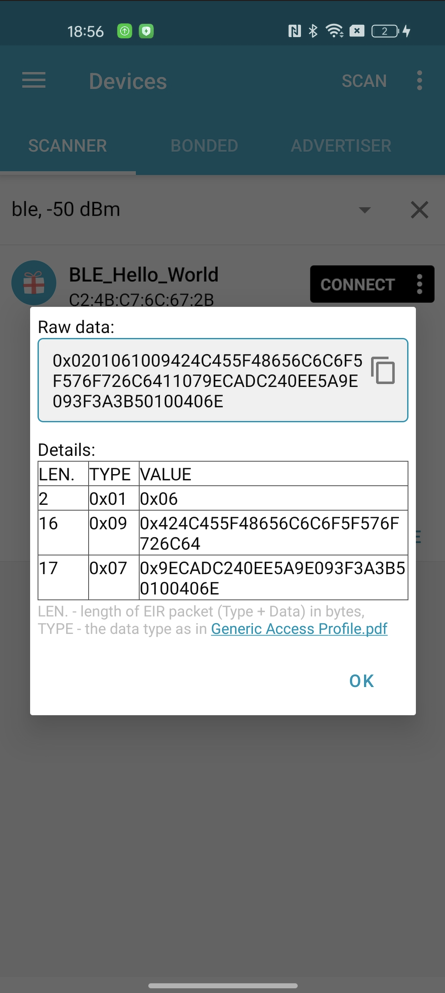
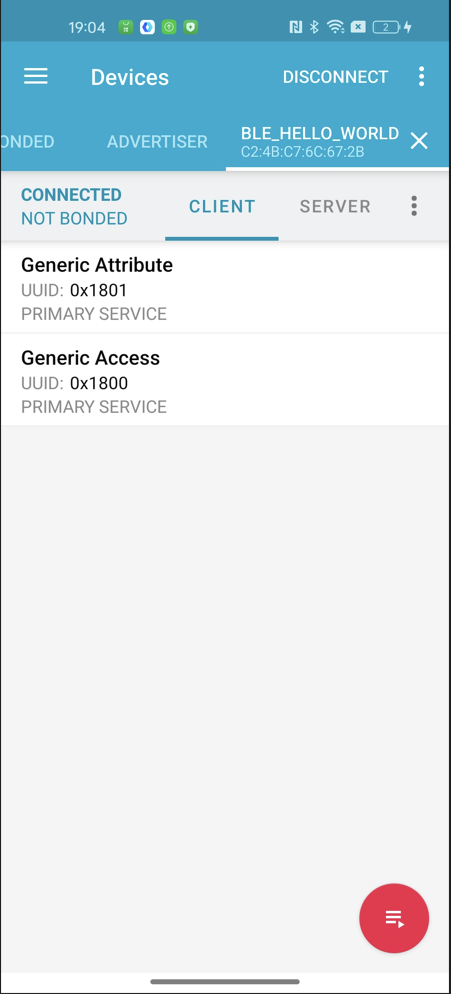
6、练习:如果你熟悉nRF5 SDK,你会发现在NCS上定义个广播参数和广播数据会比nRF5 SDK上要简单,不需要去写参数众多的指针变量,甚至可以直接用现成定义好的宏,许多参数甚至可以直接在prj.conf中定义即可,这大大减少了代码开发的工作量。这里感兴趣的读者可以去自行修改Appearance,这个参数可以通过下面这个宏来定义,修改这个宏的值然后在nRF Connect app的广播设备的图标会出现变化,SIG定义了一些标准具体的值,例如心率设备、HID设备等,具体去SIG这个网站查询:https://www.bluetooth.com/specifications/assigned-numbers
CONFIG_BT_DEVICE_APPEARANCE=0
五、BLE的连接回调
在nRF5 SDK中BLE初始化的时候会注册一个回调函数ble_evt_handler来处理BLE连接、断开连接、更新PHY、Timeout等时候的中断事件
/*nRF5 SDK中的BLE中断事件*/ /**@brief Function for handling BLE events. * * @param[in] p_ble_evt Bluetooth stack event. * @param[in] p_context Unused. */ static void ble_evt_handler(ble_evt_t const * p_ble_evt, void * p_context) { uint32_t err_code; switch (p_ble_evt->header.evt_id) { case BLE_GAP_EVT_CONNECTED: NRF_LOG_INFO("Connected"); err_code = bsp_indication_set(BSP_INDICATE_CONNECTED); APP_ERROR_CHECK(err_code); m_conn_handle = p_ble_evt->evt.gap_evt.conn_handle; err_code = nrf_ble_qwr_conn_handle_assign(&m_qwr, m_conn_handle); APP_ERROR_CHECK(err_code); break; case BLE_GAP_EVT_DISCONNECTED: NRF_LOG_INFO("Disconnected"); // LED indication will be changed when advertising starts. m_conn_handle = BLE_CONN_HANDLE_INVALID; break; case BLE_GAP_EVT_PHY_UPDATE_REQUEST: { NRF_LOG_DEBUG("PHY update request."); ble_gap_phys_t const phys = { .rx_phys = BLE_GAP_PHY_AUTO, .tx_phys = BLE_GAP_PHY_AUTO, }; err_code = sd_ble_gap_phy_update(p_ble_evt->evt.gap_evt.conn_handle, &phys); APP_ERROR_CHECK(err_code); } break; case BLE_GAP_EVT_SEC_PARAMS_REQUEST: // Pairing not supported err_code = sd_ble_gap_sec_params_reply(m_conn_handle, BLE_GAP_SEC_STATUS_PAIRING_NOT_SUPP, NULL, NULL); APP_ERROR_CHECK(err_code); break; case BLE_GATTS_EVT_SYS_ATTR_MISSING: // No system attributes have been stored. err_code = sd_ble_gatts_sys_attr_set(m_conn_handle, NULL, 0, 0); APP_ERROR_CHECK(err_code); break; case BLE_GATTC_EVT_TIMEOUT: // Disconnect on GATT Client timeout event. err_code = sd_ble_gap_disconnect(p_ble_evt->evt.gattc_evt.conn_handle, BLE_HCI_REMOTE_USER_TERMINATED_CONNECTION); APP_ERROR_CHECK(err_code); break; case BLE_GATTS_EVT_TIMEOUT: // Disconnect on GATT Server timeout event. err_code = sd_ble_gap_disconnect(p_ble_evt->evt.gatts_evt.conn_handle, BLE_HCI_REMOTE_USER_TERMINATED_CONNECTION); APP_ERROR_CHECK(err_code); break; default: // No implementation needed. break; } }
在NCS中,我们也可以这样来做,这个章节我们将演示如何在连接和断开连接的时候,打印LOG和点亮\熄灭DK的LED1。
1、首先我们在bluetooth_init()加入一个回调注册函数bt_conn_cb_register(),这个函数在conn.h,我们来看一下这个函数的声明,可以看到这个函数的主要作用就是注册一个callback用来在连接状态下监控相关事件。
/** @brief Register connection callbacks. * * Register callbacks to monitor the state of connections. * * @param cb Callback struct. Must point to memory that remains valid. * * @retval 0 Success. * @retval -EEXIST if @p cb was already registered. */ int bt_conn_cb_register(struct bt_conn_cb *cb);
从注释中我们可以看到这个函数需要输入 struct bt_conn_cb *cb 这个结构体作为入参,这个结构体的声明也在conn.h中,我们去看一下这个结构体的注释,可以看到这个结构体中给出的相关BLE回调函数是和nRF5 SDK中给出的case是相似的,感兴趣的读者可以自行查看注释来进一步做对比。
/** @brief Connection callback structure. * * This structure is used for tracking the state of a connection. * It is registered with the help of the bt_conn_cb_register() API. * It's permissible to register multiple instances of this @ref bt_conn_cb * type, in case different modules of an application are interested in * tracking the connection state. If a callback is not of interest for * an instance, it may be set to NULL and will as a consequence not be * used for that instance. */ struct bt_conn_cb { /** @brief A new connection has been established. * * This callback notifies the application of a new connection. * In case the err parameter is non-zero it means that the * connection establishment failed. * * @note If the connection was established from an advertising set then * the advertising set cannot be restarted directly from this * callback. Instead use the connected callback of the * advertising set. * * @param conn New connection object. * @param err HCI error. Zero for success, non-zero otherwise. * * @p err can mean either of the following: * - @ref BT_HCI_ERR_UNKNOWN_CONN_ID Creating the connection started by * @ref bt_conn_le_create was canceled either by the user through * @ref bt_conn_disconnect or by the timeout in the host through * @ref bt_conn_le_create_param timeout parameter, which defaults to * @kconfig{CONFIG_BT_CREATE_CONN_TIMEOUT} seconds. * - @p BT_HCI_ERR_ADV_TIMEOUT High duty cycle directed connectable * advertiser started by @ref bt_le_adv_start failed to be connected * within the timeout. */ void (*connected)(struct bt_conn *conn, uint8_t err); /** @brief A connection has been disconnected. * * This callback notifies the application that a connection * has been disconnected. * * When this callback is called the stack still has one reference to * the connection object. If the application in this callback tries to * start either a connectable advertiser or create a new connection * this might fail because there are no free connection objects * available. * To avoid this issue it is recommended to either start connectable * advertise or create a new connection using @ref k_work_submit or * increase @kconfig{CONFIG_BT_MAX_CONN}. * * @param conn Connection object. * @param reason BT_HCI_ERR_* reason for the disconnection. */ void (*disconnected)(struct bt_conn *conn, uint8_t reason); /** @brief A connection object has been returned to the pool. * * This callback notifies the application that it might be able to * allocate a connection object. No guarantee, first come, first serve. * * Use this to e.g. re-start connectable advertising or scanning. * * Treat this callback as an ISR, as it originates from * @ref bt_conn_unref which is used by the BT stack. Making * Bluetooth API calls in this context is error-prone and strongly * discouraged. */ void (*recycled)(void); /** @brief LE connection parameter update request. * * This callback notifies the application that a remote device * is requesting to update the connection parameters. The * application accepts the parameters by returning true, or * rejects them by returning false. Before accepting, the * application may also adjust the parameters to better suit * its needs. * * It is recommended for an application to have just one of these * callbacks for simplicity. However, if an application registers * multiple it needs to manage the potentially different * requirements for each callback. Each callback gets the * parameters as returned by previous callbacks, i.e. they are not * necessarily the same ones as the remote originally sent. * * If the application does not have this callback then the default * is to accept the parameters. * * @param conn Connection object. * @param param Proposed connection parameters. * * @return true to accept the parameters, or false to reject them. */ bool (*le_param_req)(struct bt_conn *conn, struct bt_le_conn_param *param); /** @brief The parameters for an LE connection have been updated. * * This callback notifies the application that the connection * parameters for an LE connection have been updated. * * @param conn Connection object. * @param interval Connection interval. * @param latency Connection latency. * @param timeout Connection supervision timeout. */ void (*le_param_updated)(struct bt_conn *conn, uint16_t interval, uint16_t latency, uint16_t timeout); #if defined(CONFIG_BT_SMP) /** @brief Remote Identity Address has been resolved. * * This callback notifies the application that a remote * Identity Address has been resolved * * @param conn Connection object. * @param rpa Resolvable Private Address. * @param identity Identity Address. */ void (*identity_resolved)(struct bt_conn *conn, const bt_addr_le_t *rpa, const bt_addr_le_t *identity); #endif /* CONFIG_BT_SMP */ #if defined(CONFIG_BT_SMP) || defined(CONFIG_BT_CLASSIC) /** @brief The security level of a connection has changed. * * This callback notifies the application that the security of a * connection has changed. * * The security level of the connection can either have been increased * or remain unchanged. An increased security level means that the * pairing procedure has been performed or the bond information from * a previous connection has been applied. If the security level * remains unchanged this means that the encryption key has been * refreshed for the connection. * * @param conn Connection object. * @param level New security level of the connection. * @param err Security error. Zero for success, non-zero otherwise. */ void (*security_changed)(struct bt_conn *conn, bt_security_t level, enum bt_security_err err); #endif /* defined(CONFIG_BT_SMP) || defined(CONFIG_BT_CLASSIC) */ #if defined(CONFIG_BT_REMOTE_INFO) /** @brief Remote information procedures has completed. * * This callback notifies the application that the remote information * has been retrieved from the remote peer. * * @param conn Connection object. * @param remote_info Connection information of remote device. */ void (*remote_info_available)(struct bt_conn *conn, struct bt_conn_remote_info *remote_info); #endif /* defined(CONFIG_BT_REMOTE_INFO) */ #if defined(CONFIG_BT_USER_PHY_UPDATE) /** @brief The PHY of the connection has changed. * * This callback notifies the application that the PHY of the * connection has changed. * * @param conn Connection object. * @param info Connection LE PHY information. */ void (*le_phy_updated)(struct bt_conn *conn, struct bt_conn_le_phy_info *param); #endif /* defined(CONFIG_BT_USER_PHY_UPDATE) */ #if defined(CONFIG_BT_USER_DATA_LEN_UPDATE) /** @brief The data length parameters of the connection has changed. * * This callback notifies the application that the maximum Link Layer * payload length or transmission time has changed. * * @param conn Connection object. * @param info Connection data length information. */ void (*le_data_len_updated)(struct bt_conn *conn, struct bt_conn_le_data_len_info *info); #endif /* defined(CONFIG_BT_USER_DATA_LEN_UPDATE) */ #if defined(CONFIG_BT_DF_CONNECTION_CTE_RX) /** @brief Callback for IQ samples report collected when sampling * CTE received by data channel PDU. * * @param conn The connection object. * @param iq_report Report data for collected IQ samples. */ void (*cte_report_cb)(struct bt_conn *conn, const struct bt_df_conn_iq_samples_report *iq_report); #endif /* CONFIG_BT_DF_CONNECTION_CTE_RX */ #if defined(CONFIG_BT_TRANSMIT_POWER_CONTROL) /** @brief LE Read Remote Transmit Power Level procedure has completed or LE * Transmit Power Reporting event. * * This callback notifies the application that either the remote transmit power level * has been read from the peer or transmit power level has changed for the local or * remote controller when transmit power reporting is enabled for the respective side * using @ref bt_conn_le_set_tx_power_report_enable. * * @param conn Connection object. * @param report Transmit power report. */ void (*tx_power_report)(struct bt_conn *conn, const struct bt_conn_le_tx_power_report *report); #endif /* CONFIG_BT_TRANSMIT_POWER_CONTROL */ #if defined(CONFIG_BT_PATH_LOSS_MONITORING) /** @brief LE Path Loss Threshold event. * * This callback notifies the application that there has been a path loss threshold * crossing or reporting the initial path loss threshold zone after using * @ref bt_conn_le_set_path_loss_mon_enable. * * @param conn Connection object. * @param report Path loss threshold report. */ void (*path_loss_threshold_report)(struct bt_conn *conn, const struct bt_conn_le_path_loss_threshold_report *report); #endif /* CONFIG_BT_PATH_LOSS_MONITORING */ #if defined(CONFIG_BT_SUBRATING) /** @brief LE Subrate Changed event. * * This callback notifies the application that the subrating parameters * of the connection may have changed. * The connection subrating parameters will be unchanged * if status is not BT_HCI_ERR_SUCCESS. * * @param conn Connection object. * @param params New subrating parameters. */ void (*subrate_changed)(struct bt_conn *conn, const struct bt_conn_le_subrate_changed *params); #endif /* CONFIG_BT_SUBRATING */ #if defined(CONFIG_BT_CHANNEL_SOUNDING) /** @brief LE CS Read Remote Supported Capabilities Complete event. * * This callback notifies the application that the remote channel * sounding capabilities have been received from the peer. * * @param conn Connection object. * @param remote_cs_capabilities Remote Channel Sounding Capabilities. */ void (*le_cs_remote_capabilities_available)(struct bt_conn *conn, struct bt_conn_le_cs_capabilities *params); /** @brief LE CS Read Remote FAE Table Complete event. * * This callback notifies the application that the remote mode-0 * FAE Table has been received from the peer. * * @param conn Connection object. * @param params FAE Table. */ void (*le_cs_remote_fae_table_available)(struct bt_conn *conn, struct bt_conn_le_cs_fae_table *params); /** @brief LE CS Config created. * * This callback notifies the application that a Channel Sounding * Configuration procedure has completed and a new CS config is created * * @param conn Connection object. * @param config CS configuration. */ void (*le_cs_config_created)(struct bt_conn *conn, struct bt_conn_le_cs_config *config); /** @brief LE CS Config removed. * * This callback notifies the application that a Channel Sounding * Configuration procedure has completed and a CS config is removed * * @param conn Connection object. * @param config_id ID of the CS configuration that was removed. */ void (*le_cs_config_removed)(struct bt_conn *conn, uint8_t config_id); /** @brief Subevent Results from a CS procedure are available. * * This callback notifies the user that CS subevent results are * available for the given connection object. * * @param conn Connection objects. * @param result Subevent results */ void (*le_cs_subevent_data_available)(struct bt_conn *conn, struct bt_conn_le_cs_subevent_result *result); /** @brief LE CS Security Enabled. * * This callback notifies the application that a Channel Sounding * Security Enable procedure has completed * * @param conn Connection object. */ void (*le_cs_security_enabled)(struct bt_conn *conn); /** @brief LE CS Procedure Enabled. * * This callback notifies the application that a Channel Sounding * Procedure Enable procedure has completed * * @param conn Connection object. * @param params CS Procedure Enable parameters */ void (*le_cs_procedure_enabled)( struct bt_conn *conn, struct bt_conn_le_cs_procedure_enable_complete *params); #endif /** @internal Internally used field for list handling */ sys_snode_t _node; };
2、这里我们还是来演示如何使用CONNECT和DISCONNECT这两个回调来在BLE断开和连接的时候处理相关任务。首先我们来写一个结构体ble_connection_callback ,这个结构体里面包括两个函数ble_on_connected和ble_on_connected
这里我们需要调用bt_conn_get_dst这个函数来获取对端设备的MAC地址,并调用bt_addr_le_to_str将获取到的地址转成字符串用于打印。
/** @brief Get destination (peer) address of a connection.
*
* @param conn Connection object.
*
* @return Destination address.
*/
const bt_addr_le_t *bt_conn_get_dst(const struct bt_conn *conn);
/** @brief Converts binary LE Bluetooth address to string.
*
* @param addr Address of buffer containing binary LE Bluetooth address.
* @param str Address of user buffer with enough room to store
* formatted string containing binary LE address.
* @param len Length of data to be copied to user string buffer. Refer to
* BT_ADDR_LE_STR_LEN about recommended value.
*
* @return Number of successfully formatted bytes from binary address.
*/
static inline int bt_addr_le_to_str(const bt_addr_le_t *addr, char *str,
size_t len)
在连接和断开异常的时候我们还可以调用bt_hci_err_to_str来获取相关的错误代码。
/** Converts a HCI error to string. * * The error codes are described in the Bluetooth Core specification, * Vol 1, Part F, Section 2. * * The HCI documentation found in Vol 4, Part E, * describes when the different error codes are used. * * See also the defined BT_HCI_ERR_* macros. * * @return The string representation of the HCI error code. * If @kconfig{CONFIG_BT_HCI_ERR_TO_STR} is not enabled, * this just returns the empty string */ #if defined(CONFIG_BT_HCI_ERR_TO_STR) const char *bt_hci_err_to_str(uint8_t hci_err); #else static inline const char *bt_hci_err_to_str(uint8_t hci_err)
最后调用dk_set_led_on和dk_set_led_off来点亮和熄灭nRF54L15 DK的LED1。
3、接下来我们来写ble_on_connected和ble_on_connected这两个回调函数
static void ble_on_connected(struct bt_conn *conn, uint8_t err) { char addr[BT_ADDR_LE_STR_LEN]; /*Print err code when the connection is error*/ if (err) { LOG_ERR("Connection failed, err 0x%02x %s", err, bt_hci_err_to_str(err)); return; }
/*Print the MAC address of Central Deevice*/ bt_addr_le_to_str(bt_conn_get_dst(conn), addr, sizeof(addr)); LOG_INF("Connected %s", addr);
/*Count the coennection*/ current_conn = bt_conn_ref(conn); dk_set_led_on(DK_LED1)
);
}
static void ble_on_disconnected(struct bt_conn *conn, uint8_t reason) { char addr[BT_ADDR_LE_STR_LEN]; /*Get the MAC address of central and print it when the connection is disconnected*/ bt_addr_le_to_str(bt_conn_get_dst(conn), addr, sizeof(addr)); LOG_INF("Disconnected: %s, reason 0x%02x %s", addr, reason, bt_hci_err_to_str(reason)); /*Decrement a connection's reference count and off LED1 of DK*/ if (current_conn) { bt_conn_unref(current_conn); current_conn = NULL; dk_set_led_off(DK_LED1);
}
}
这里我们引入了一个全局变量current_conn用于计数已连接的设备数量,所以需要做一个声明
static struct bt_conn *current_conn;
此外我们调用了LED1这个外设用来指示BLE的连接情况,所以我们还需要在main中初始化LED1这个外设,这里我们需要加入一些头文件并在prj.conf中使能相关的宏,最后在main中调用configure_gpio。
//Add LED and Button drivers Library file #include <dk_buttons_and_leds.h>
# Enable DK LED and Buttons library CONFIG_DK_LIBRARY=y CONFIG_GPIO=y
static void configure_gpio(void) { int err_code; err_code = dk_leds_init(); if (err_code) { LOG_ERR("Cannot init LEDs (err: %d)", err_code); } }
4、完成上述步骤之后,我们将ble_connection_callback这个函数注册到bluetooth_init中
int bluetooth_init(struct bt_conn_cb *ble_cb) { int err_code; LOG_INF("Initiallzing BLE"); if (ble_cb == NULL) { return -NRFX_ERROR_NULL; } bt_conn_cb_register(ble_cb); err_code = bt_enable(bt_ready_callback); if(err_code) { LOG_ERR("BLE Enable returned %d",err_code); return err_code; } k_sem_take(&ble_init_ok, K_FOREVER); err_code = bt_le_adv_start(BT_LE_ADV_CONN, ad, ARRAY_SIZE(ad), srd, ARRAY_SIZE(srd)); if (err_code) { LOG_ERR("Advertising failed to start (err_code %d)", err_code); return 0; } return err_code; }
int main(void) { int err_code; configure_gpio(); err_code = bluetooth_init(&ble_connection_callback); if(err_code) { LOG_ERR("Bluetooth_init returnrd %d", err_code); } printf("Hello World! %s\n", CONFIG_BOARD_TARGET); }
5、最后我们编译下载工程到nRF54L15的DK中,使用nRF Connect APP连接可以看到连接和断开之后分别打印了手机端的MAC地址

同时DK的LED1在连接之后常亮
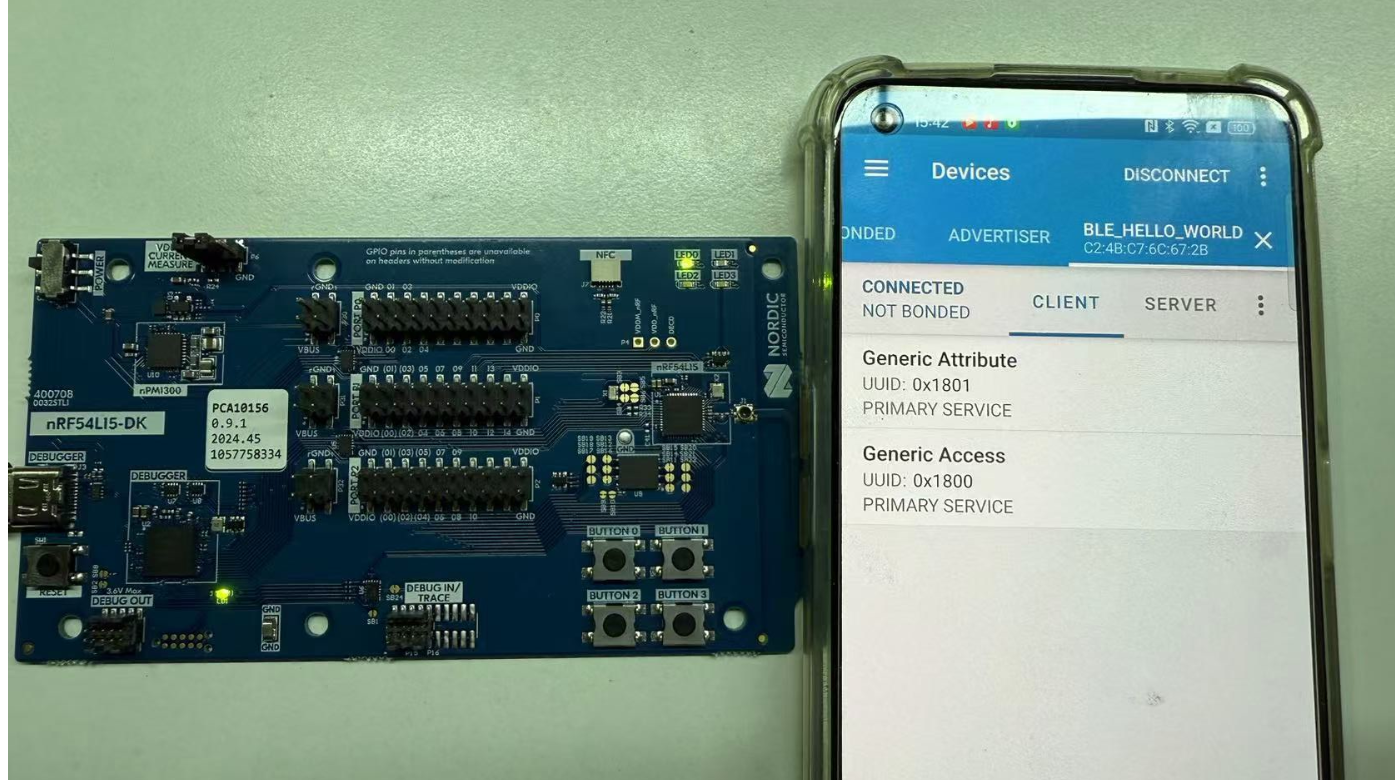
六、添加一个Service
1、从上面的图片中可以看到,APP连接nRF54L15 DK之后只有一些通用的Service,这一步我们来演示如何添加一个自定义的Service,在nRF5 SDK中我们需要在service_init中初始化给相关的指针写入值,但在NCS中我们可以直接调用BT_GATT_SERVICE_DEFINE来实现
/** * @brief Statically define and register a service. * * Helper macro to statically define and register a service. * * @param _name Service name. */ #define BT_GATT_SERVICE_DEFINE(_name, ...) \ const struct bt_gatt_attr attr_##_name[] = { __VA_ARGS__ }; \ const STRUCT_SECTION_ITERABLE(bt_gatt_service_static, _name) = \ BT_GATT_SERVICE(attr_##_name) #define _BT_GATT_ATTRS_ARRAY_DEFINE(n, _instances, _attrs_def) \ static struct bt_gatt_attr attrs_##n[] = _attrs_def(_instances[n]) #define _BT_GATT_SERVICE_ARRAY_ITEM(_n, _) BT_GATT_SERVICE(attrs_##_n)
2、这里我直接用了NUS服务的UUID,当然你可以自己定义一个UUID看一下有什么效果
/** @brief UUID of the NUS Service. **/ #define BT_UUID_HOWD_VAL \ BT_UUID_128_ENCODE(0x6e400001, 0xb5a3, 0xf393, 0xe0a9, 0xe50e24dcca9e) #define BT_UUID_HOWD_SERVICE BT_UUID_DECLARE_128(BT_UUID_HOWD_VAL) #define SERVICE_NAME nus_svc BT_GATT_SERVICE_DEFINE(SERVICE_NAME, BT_GATT_PRIMARY_SERVICE(BT_UUID_HOWD_SERVICE) );
3、最后编译一下工程下载的nRF54L15DK,并使用nRF Connect APP连接中可以看到多了一个NUS服务。
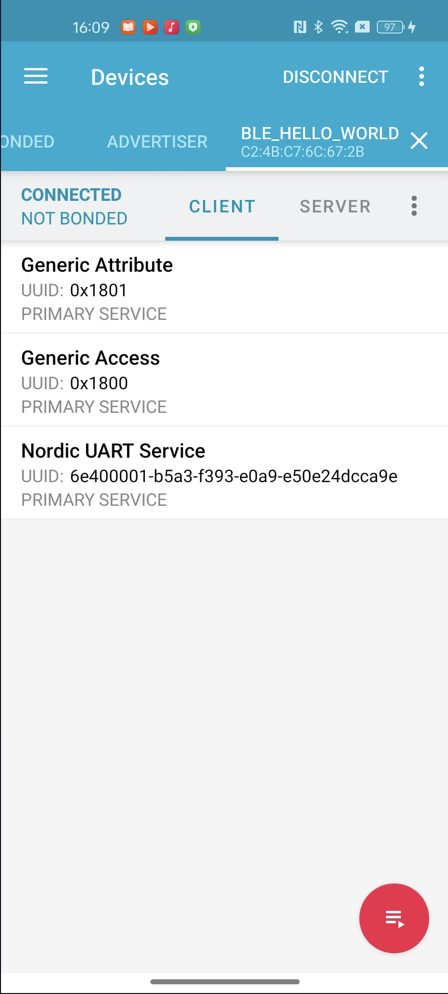
七、添加特征值并定义其属性
1、完成上述步骤之后,BLE多了一个Service,但是这个Service中没有Characteristic(特征值),这里我们还可以在BT_GATT_SERVICE_DEFINE中调用BT_GATT_CHARACTERISTIC,将特征值放在Service下面,这个结构就像APP上Service下面有特征值那样,非常直观。这里我们去看一下BT_GATT_CHARACTERISTIC,会发现它一共有6个入参
1)_uuid是特征值的UUID
2)_props是特征值的属性,比如:read,write,Notify,indicate等
3)_perm是属性的访问权限,比如:普通、加密、配对等
4)_read、_write是分别是读取和写入的回调函数
5)_user_data是留给用户自定义的一些数据,一般不用
/** * @brief Characteristic and Value Declaration Macro. * * Helper macro to declare a characteristic attribute along with its * attribute value. * * @param _uuid Characteristic attribute uuid. * @param _props Characteristic attribute properties, * a bitmap of ``BT_GATT_CHRC_*`` macros. * @param _perm Characteristic Attribute access permissions, * a bitmap of @ref bt_gatt_perm values. * @param _read Characteristic Attribute read callback * (@ref bt_gatt_attr_read_func_t). * @param _write Characteristic Attribute write callback * (@ref bt_gatt_attr_write_func_t). * @param _user_data Characteristic Attribute user data. */ #define BT_GATT_CHARACTERISTIC(_uuid, _props, _perm, _read, _write, _user_data) \ BT_GATT_ATTRIBUTE(BT_UUID_GATT_CHRC, BT_GATT_PERM_READ, \ bt_gatt_attr_read_chrc, NULL, \ ((struct bt_gatt_chrc[]) { \ BT_GATT_CHRC_INIT(_uuid, 0U, _props), \ })), \ BT_GATT_ATTRIBUTE(_uuid, _perm, _read, _write, _user_data)
2、这里因为我们这个特征值的属性是Read,所以我们需要在写一个回调,在里面将Button的键值通过GATT接口发送出去,这需要用到一个库函数bt_gatt_attr_read,这个函数的声明在gatt.h中,可以看到这个函数的作用是将本地数据通过Read属性上传
/** @brief Generic Read Attribute value helper. * * Read attribute value from local database storing the result into buffer. * * @param conn Connection object. * @param attr Attribute to read. * @param buf Buffer to store the value. * @param buf_len Buffer length. * @param offset Start offset. * @param value Attribute value. * @param value_len Length of the attribute value. * * @return number of bytes read in case of success or negative values in * case of error. */ ssize_t bt_gatt_attr_read(struct bt_conn *conn, const struct bt_gatt_attr *attr, void *buf, uint16_t buf_len, uint16_t offset, const void *value, uint16_t value_len);
3、我们来尝试加一个Read属性的特征值,读取按键DK上按下的Button的键值,从BT_GATT_CHARACTERISTIC的注释中可以看到,要使用这个宏需要写一个回调函数,首先来声明以下这个回调函数,并将bt_gatt_attr_read的入参作为回调函数的入参
ssize_t read_button_characteristic_cb(struct bt_conn *conn, const struct bt_gatt_attr *attr,
void *buf, uint16_t len, uint16_t offset);
这个函数的实际功能是在Read这个特征值的时候,将键值上传给GATT,所以我们来定义一个全局变量来获取button的键值
static uint8_t button_value = 0;
然后将button_value通过bt_gatt_attr_read上传给GATT
ssize_t read_button_characteristic_cb(struct bt_conn *conn, const struct bt_gatt_attr *attr, void *buf, uint16_t len, uint16_t offset) { return bt_gatt_attr_read(conn, attr, buf, len, offset, &button_value, sizeof(button_value)); }
4、将这个回调放入BT_GATT_CHARACTERISTIC中,并写入这个Read特征值的属性等相关配置。
这里的特征值的UUID我用了NUS服务TX的特征值;
BT_GATT_CHRC_READ表示特征值的属性是Read
BT_GATT_PERM_READ表示特征值的访问权限为普通读取
读取的回调使用我们写好的read_button_characteristic_cb这个函数
因为这个特征值只是Read属性,所以不需要Write的回调,也不需要用户自定义数据,所以最后两个入参填写为NULL
#define BT_UUID_NUS_TX_VAL \ BT_UUID_128_ENCODE(0x6e400003, 0xb5a3, 0xf393, 0xe0a9, 0xe50e24dcca9e) #define BT_UUID_NUS_TX BT_UUID_DECLARE_128(BT_UUID_NUS_TX_VAL) BT_GATT_SERVICE_DEFINE(SERVICE_NAME, BT_GATT_PRIMARY_SERVICE(BT_UUID_NUS_SERVICE), BT_GATT_CHARACTERISTIC(BT_UUID_NUS_TX, BT_GATT_CHRC_READ, BT_GATT_PERM_READ, read_button_characteristic_cb, NULL, NULL), );
GATT的属性和权限除了上述两个参数之外,还有其他类型,感兴趣的读者具体可以去gatt.h中查看相关注释说明。
5、至此我们已经完成了BLE数据上传部分的代码编写,接下来我们来读取Button的键值,并将这个值给到全局变量button_value即可。这里我们写一个函数来传递button的键值
void set_button_value(uint8_t btn_value) { button_value = btn_value; }
我们还需要通过GPIO外设来读取键值,和点亮LED一样,需要先将DK的Button初始化,这里要调用dk_buttons_init来完成,它是一个库函数,函数声明在dk_buttons_and_leds.h中。
/** @brief Initialize the library to read the button state. * * @param button_handler Callback handler for button state changes. * * @retval 0 If the operation was successful. * Otherwise, a (negative) error code is returned. */ int dk_buttons_init(button_handler_t button_handler); /** * @typedef button_handler_t * @brief Callback that is executed when a button state change is detected. * * @param button_state Bitmask of button states. * @param has_changed Bitmask that shows which buttons have changed. */ typedef void (*button_handler_t)(uint32_t button_state, uint32_t has_changed);
从注释可以看到这个函数需要一个button的回调函数,用于处理button时候的中断。我们来写这个回调,在里面处理不同按键按下之后,定义不同的键值,并通过LOG打印键值,最后调用set_button_value将键值传递给全局变量button_value。
void button_handler(uint32_t button_state, uint32_t has_changed) { int button_pressed = 0; if (has_changed & button_state) { if (DK_BTN1_MSK & has_changed) { button_pressed = 1; } if (DK_BTN2_MSK & has_changed) { button_pressed = 2; } if (DK_BTN3_MSK & has_changed) { button_pressed = 3; } if (DK_BTN4_MSK & has_changed) { button_pressed = 4; } LOG_INF("Button %d pressed", button_pressed); set_button_value(button_pressed); } }
最后在GPIO初始化里面调用dk_buttons_init并写入回调函数button_handler即可。
static void configure_gpio(void) { int err_code; err_code = dk_buttons_init(button_handler); if (err_code) { LOG_ERR("Cannot init buttons (err: %d)", err_code); } err_code = dk_leds_init(); if (err_code) { LOG_ERR("Cannot init LEDs (err: %d)", err_code); } }
6、最后编译工程,并使用nRF Connect APP连接nRF54L15DK的广播,可以看到NUS Service下多了一个Read属性,当我们按下DK上的Button的时候,可以读取到对应的键值。

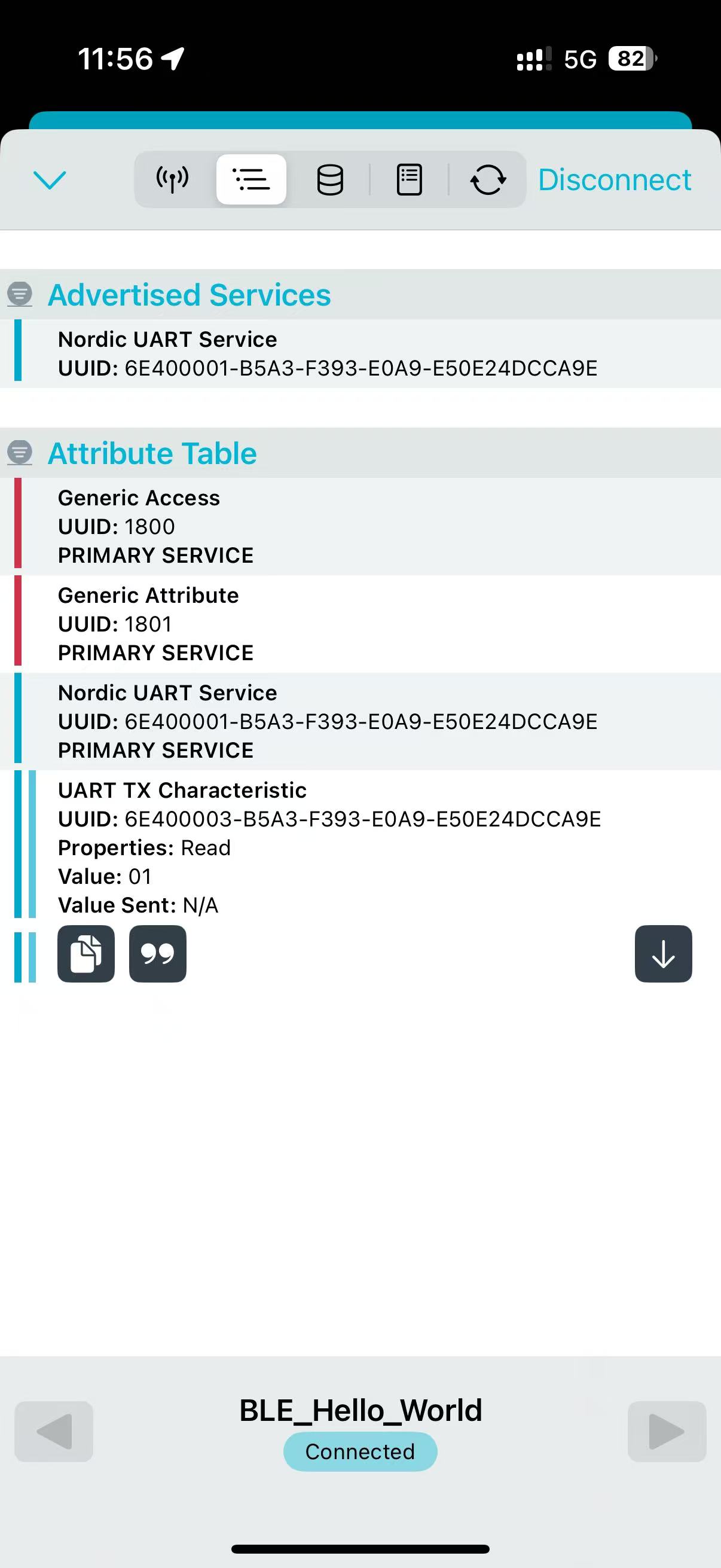
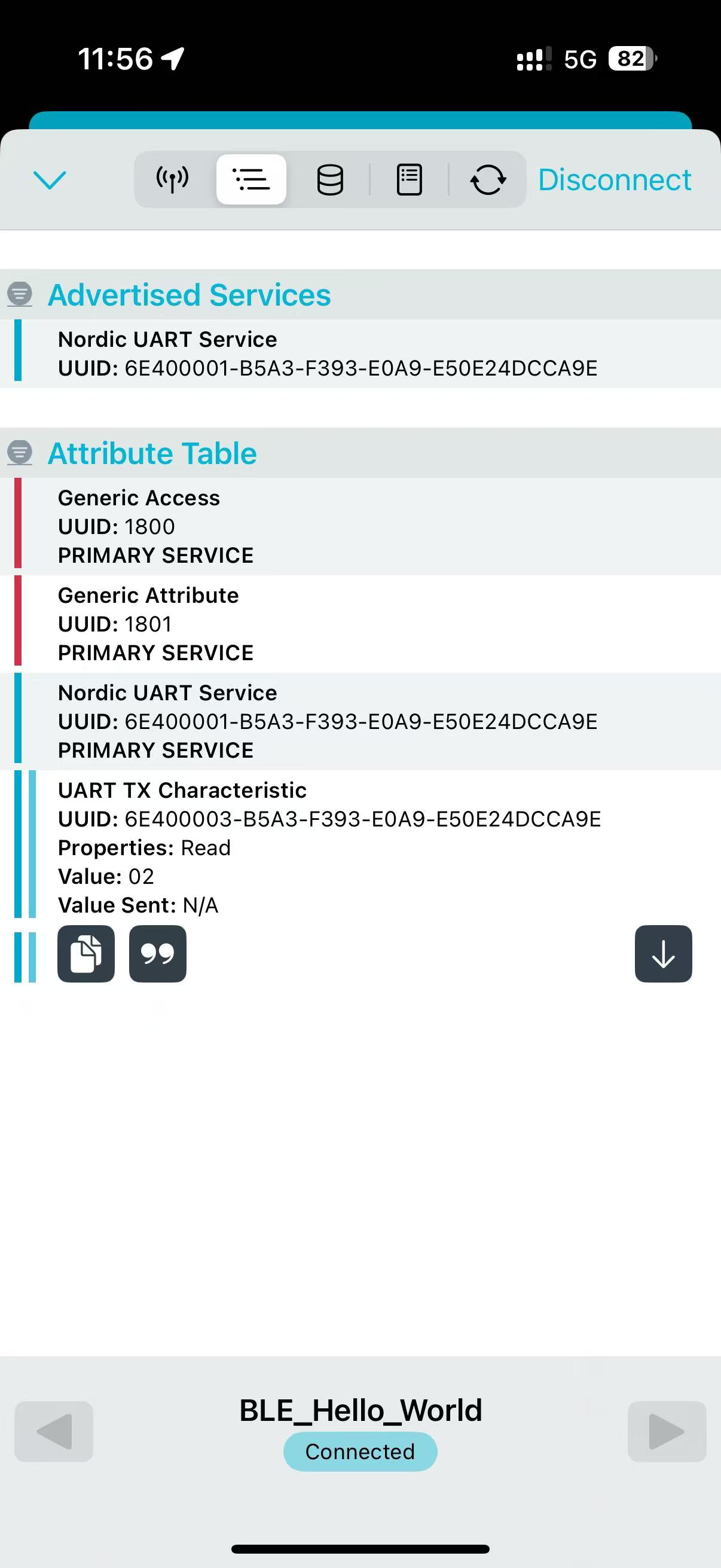
持续未完........





 浙公网安备 33010602011771号
浙公网安备 33010602011771号